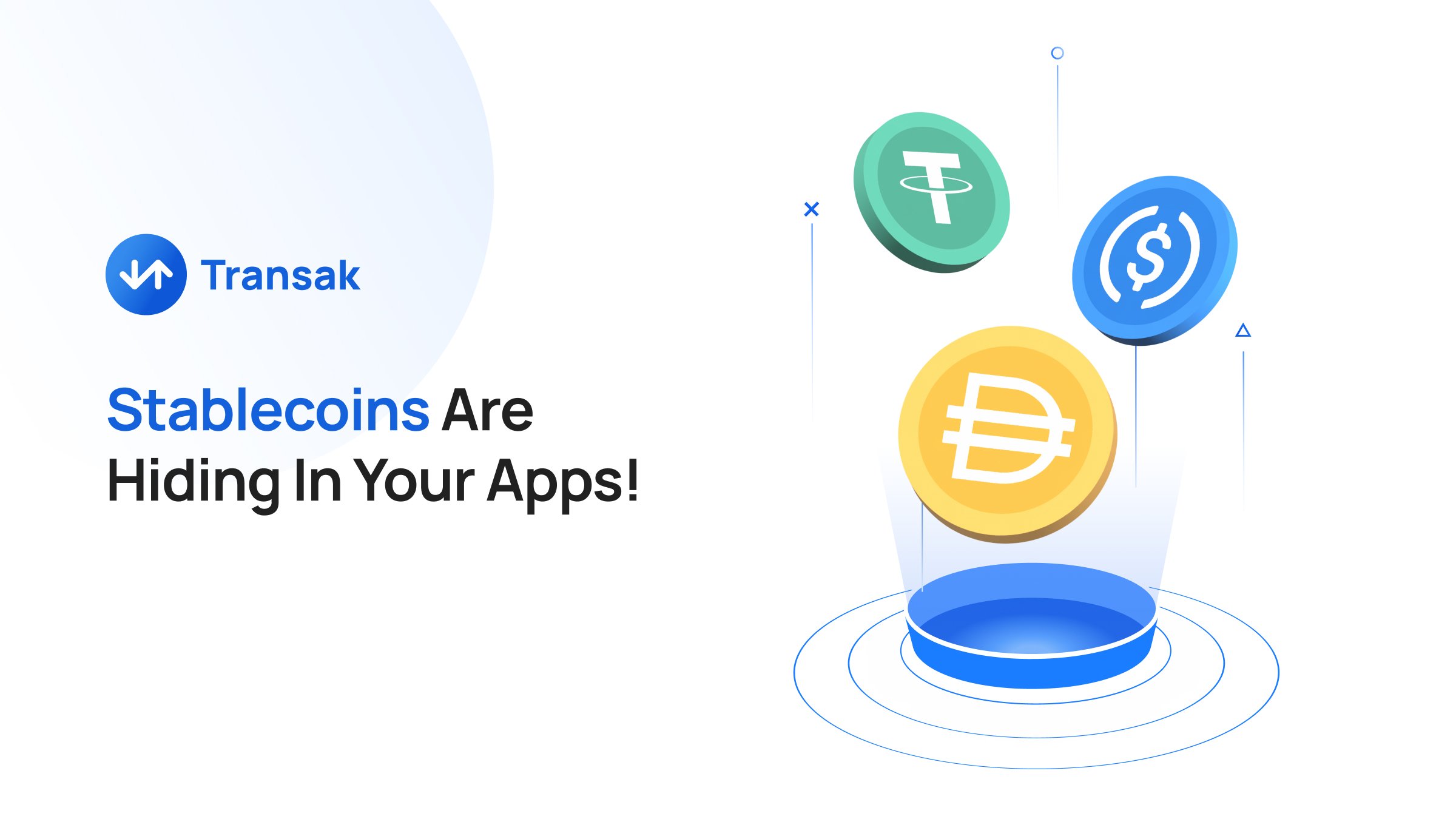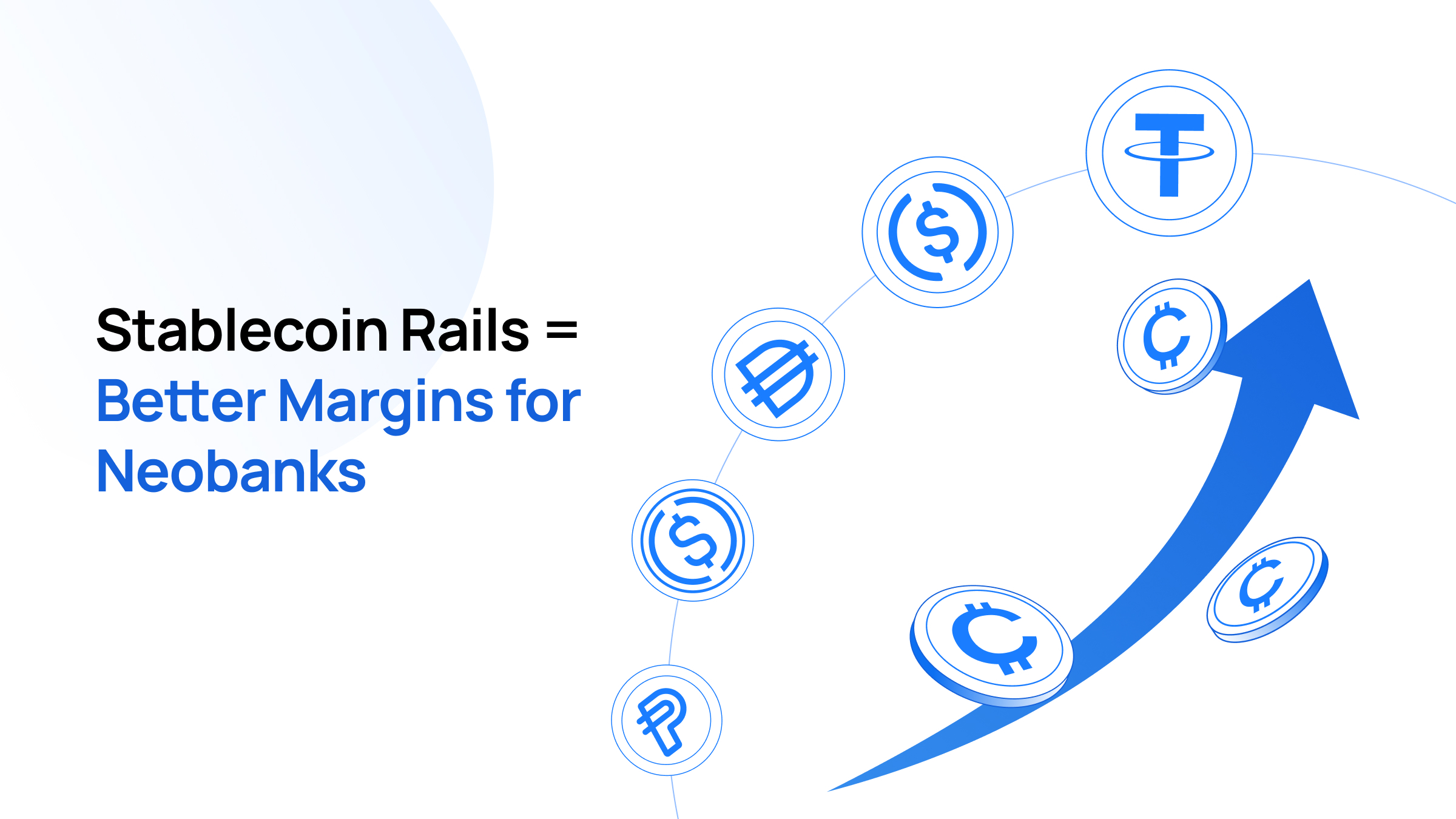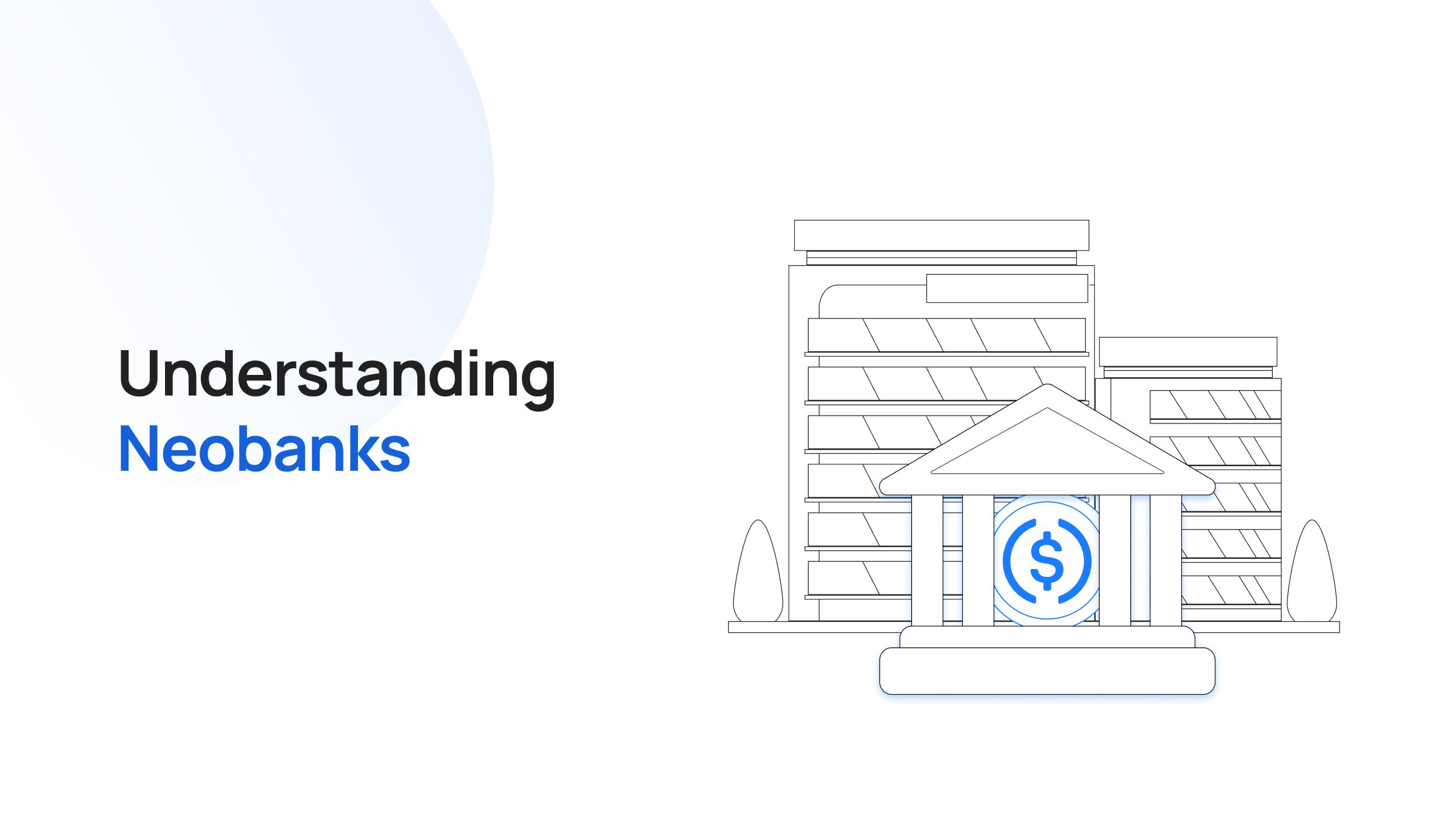Takeaways
Embedded finance is how stablecoins could go mainstream.
Stablecoins are fast, borderless, and stable in value, making them the ideal digital cash for the internet age. But the irony is, most people who want to use stablecoins still can't get them easily.
Why? Because the infrastructure is broken, fragmented, or simply too technical to be well-integrated.
Embedded finance is the invisible force making stablecoins accessible right inside the apps people already use. Let’s learn about it in this article.
What Is Embedded Finance?
Embedded finance integrates financial services into non-financial platforms. Customers can access banking, payments, and lending services directly on the platform without visiting traditional banks.
The term "embedded" here means services living directly within the platform. The third-party bank disappears from view, allowing customers to perform all tasks within a single app. Services appear only when customers need them (via APIs and SDKs) enabling this entire integration.
The "Buy Now, Pay Later" option you see at checkout on e-commerce sites is an example of embedded finance. That payment or loan service is powered by a financial provider, but you never have to leave the shopping platform. The finance is embedded in the experience.
The evolution simplifies (and redefines) the concept of buying, unlocking new revenues for:
- Non-financial companies looking to gain new revenue streams, and
- Financial partners searching for access to new profit opportunities.
In simple terms, it's a middleware approach that helps cut recurring steps, making transactions easier. Businesses gain simpler operations, improve customer experience, and loyalty.
6 Key Differences Between TradFi vs. Stablecoin Embedded Finance
While neither can be discarded when considering accessibility to the masses, the two approaches represent a clash between slow, permissioned infrastructure and fast, permissionless on-chain liquidity.
"The proliferation of dollar stablecoins — rendered possible by the ubiquity of smartphones and the cryptography of blockchains — could become the greatest experiment in financial empowerment humanity has ever undertaken."
– Rep. Ritchie Torres (D-N.Y.)
Here’s how the old-world TradFi model contrasts with the new on-chain stablecoin reality.
Aspect |
Traditional Banking Approach |
Stablecoin Approach |
|---|---|---|
|
The Tech Stack |
Platforms pipe legacy bank infrastructure into apps via APIs, building on a closed, centralized system. |
Platforms plug directly into on-chain protocols where the blockchain is the payment rail. |
|
The Gatekeepers |
This model relies on a licensed bank as the mandatory middleman for infrastructure and compliance. |
It's designed to cut out middlemen. The only gatekeeper is the code itself. |
|
Speed & Fees |
Transactions settle in days (T+2, ACH lag), with costs dictated by interchange and intermediary fees. |
Transactions settle in seconds, 24/7. Costs are just gas fees—often pennies on an L2. |
|
Global Reach |
Reach is geofenced by partner bank jurisdictions, making cross-border transactions slow and expensive. |
It's borderless by default, making the network accessible to anyone with a wallet. |
|
Programmable Money |
Functionality is dictated by the bank partner's API, limiting what can be automated. |
It enables money that runs on code. Smart contracts can automatically trigger escrow, royalties, or complex payouts. |
|
Rules & Reversals |
Reversals are handled by the slow, expensive, and centralized chargeback system. |
On-chain transactions are final, but disputes can be handled via programmable smart contracts (think on-chain escrow). |
Embedded Finance Market Stats and What They Mean for Stablecoins
Let's review some key stats to better understand how the multi-trillion-dollar opportunities are shaping up.
Growth Metrics
- The global embedded finance revenue was $82.32 billion in 2023, with projections reaching $7.2 trillion by 2030.
- Africa and the Middle East are experiencing strong growth, expected to reach $37.68 billion by 2029.
- The stablecoins market holds $260 billion in assets and may grow to $5 trillion by 2030.
Source: Grand View Research
"Research shows that 90% of firms are moving forward with stablecoin implementations because they see it as a key lever for growth."
– Ran Goldi, Senior VP, Payments and Network at Fireblocks
The crux boils down to making stablecoins the invisible, default plumbing for the internet's financial layer.
Real-World Adoption Examples: "Embedding" Stablecoin Utility For The Masses
Let’s review some key scenarios of stablecoin embedded finance.
Example 1: Visa's USDC Integration for Merchant Settlements
Visa is exploring the use of USDC for merchant payments, a step toward modernizing cross-border money transfers.
Source: Visa
They are doing this via public blockchains like Ethereum and Solana, making transactions faster and more transparent for services like Crypto.com, Worldpay, and Nuvei. This allows merchants to receive funds quicker and more efficiently, increasing payment options.
"I would view stablecoins as an enormous opportunity. As I said, we're in the very early days, but ultimately, our network model is to be the best … in all the payments in Money Movement that I just talked about."
– Christopher T. Newkirk, President, Commercial & Money Movement Solutions, Visa, Inc.
Visa already handles payments in hundreds of currencies worldwide. They see stablecoins as tomorrow’s opportunity for mass digital payment routes, using which they seek to reach ~150 million merchant locations globally.
Not only this, but they’re also exploring a method called the "stablecoin sandwich," which uses stablecoins and blockchain tech for cross-border transfers between fiat currencies.
Example 2: Stripe, Bolt, & PayPal Pushing Stablecoin Use
Beyond direct settlements, embedded finance platforms like Stripe are helping businesses add financial services to their products.
For example, Stripe Treasury offers banking-as-a-service (BaaS) APIs, letting merchants accept USDC payments and automatically receive local fiat currency, usually USD. This makes international sales much easier.
"With Bolt Connect, we're giving them the tools … while stablecoin support opens the door to faster, borderless payments for everyone in the network."
– Ryan Breslow, Founder and CEO of Bolt
Bolt also supports stablecoin payments for marketplaces, enabling faster settlements, lower transaction costs, and instant payments without foreign fees. Bolt Connect simplifies this by reducing technical work. PayPal is also exploring its own stablecoin, PYUSD, for business transactions.
All this indicates a broader trend: non-traditional financial firms are now preferring stablecoin-embedded finance to boost sales, build loyalty, and make UX easier by integrating financial services into their platforms.
Example 3: Circle's Refund Protocol for Trust
Whether it’s banking, SaaS, or DeFi, handling payment disputes is central to retaining acquired customer bases. Circle's Refund Protocol helps with this by offering a non-custodial dispute resolution system.
Source: Circle
It uses smart contracts to temporarily lock stablecoin funds in escrow for a set period. During this time, a neutral mediator can step in to resolve disputes. The system relies on trustless arbiters who oversee the locked funds.
The control, however, is limited, i.e., arbiters can only approve refunds to specific addresses or allow early withdrawals for a negotiated fee, but cannot transfer funds freely to any address.
This setup keeps everything transparent and accountable while building confidence, making stablecoins more suitable for everyday transactions.
Example 4: Embedded Investing/Banking by Cash App, Revolut, Uber, and others
Companies like Cash App, Robinhood, and Revolut are adding investment and banking features, including stablecoin options, right into user interfaces. They do this by combining multiple financial tasks (like direct deposits, savings, buying and selling stocks, and cryptocurrencies) into one easy-to-use app.
Shopify Balance also offers business banking and card services directly to Shopify merchants. This lets them manage funds, get paid faster, and use business debit cards with rewards, all within their existing Shopify platform.
Similarly, Uber and Lyft give their drivers instant earnings deposits and branded debit cards through their apps. This makes managing money simpler and more convenient, tailored to what users need in these ecosystems.
Example 5: Boosting Financial Inclusion in Emerging Markets
Stablecoins play a key role in empowering people financially, especially those who lack easy access to traditional banking in emerging markets.
Regular banks often avoid these areas because it’s hard and expensive to meet all the rules for anti-money laundering (AML) and counter-terrorist financing (CTF). Plus, the financial systems are often fragmented and costly to operate. Stablecoins help address these issues by enabling quick, inexpensive, and 24/7 cross-border payments.
For instance, sending USDC on the Base network costs less than a cent. That’s a big difference compared to the usual $8 to $14 fee for a $200 remittance through traditional systems to regions like Sub-Saharan Africa, which can be 4% to 7% of the total amount.
Argentina and Nigeria are also increasingly using stablecoins to address local currency problems and facilitate international payments, especially where banking is difficult. It's helping to strengthen their economies.
Risks Associated With Stablecoin-Embedded Finance
Successfully embedding stablecoins requires a clear-eyed view of the key hurdles in technology, governance, and market stability.
"Our bank has been around for almost eight years, we consider ourselves a start-up. WeBank’s strategy is to provide better, more inclusive financial services—to the mass population … with leading technology. We do business 100 percent online, so we rely on technology."
– Arthur Wang, CFO of WeBank
These challenges break down across the regulatory, technical, and economic layers of the stack.
1. Regulatory & Compliance Headaches
The regulatory landscape is fragmented, making global operations difficult.
Non-financial firms face complex compliance burdens (KYC, AML), and partner banks face significant risk, as shown by Blue Ridge’s and Choice Financial’s recent consent orders.
This creates a high-stakes environment where internal compliance struggles to keep pace with the growth of fintech programs.
2. Depegging & Financial Stability Risk
While designed to maintain a 1:1 peg with the native dollar, stablecoins still carry the risk of depegging.
Such an event would cause direct financial losses for users, crippling trust in the stablecoin itself and any embedded service that relies on it. It’s a low-probability but high-impact threat to the entire model.
3. Technical & Ecosystem Friction
High network activity can cause transaction delays and expensive gas fees, undermining the promise of speed and low cost.
Widespread adoption is also bottlenecked by the need for wallet providers to integrate new protocols, creating a significant gap between a protocol’s potential and its real-world usability across the ecosystem.
4. On-Chain Governance & Custody Risks
A malicious arbiter could approve unjustified refunds, harming merchants.
If the protocol grants an arbiter control over refund destinations, it compromises its non-custodial security and centralizes power, thereby undermining the trustless design.
5. Economic Drag from Idle Capital
Funds locked in on-chain escrow during dispute periods are typically unproductive, generating no yield. This represents a significant opportunity cost, making the system less capital-efficient than it could be.
While future upgrades may merge lending protocols, for now, this remains a key economic drawback of on-chain dispute systems.
The Future for Stablecoins Is Not Embedded; It's Dissolved
The evolution of embedded finance is less a single trend and more a fundamental rewiring of how value moves.
"For banks, it can be challenging to have a long-term commitment, even if they have a specific niche. Itʼs a big fight to take on, and one thatʼs better to fight together."
– Hugo Bongers, Head of ABN AMRO Ventures
Defined as ‘coopetition,’ it’s where banks and fintechs collaborate rather than compete, enabling a massive distribution shift.
Non-financial platforms now unbundle and re-bundle services, embedding them directly at the point of need. Powering this is AI automation, which adds a layer of hyper-personalization and security to these new user experiences.
The final frontier of this evolution is embedded crypto investing, particularly with stablecoins.
Imagine future crypto wallets becoming central hubs, requiring apps to get permission to make payments, prioritizing the wallet over the app. Your "on-chain dollars" (USDT/USDC) would be stored on a global blockchain, unrestricted by borders or banking hours, serving as a universal key to instantly access services worldwide.
This would make financial actions, like loans or payments, seamless, automated network functions as natural as "copy and paste."
FAQs
1. What is stablecoin-embedded finance?
Stablecoin-embedded finance involves integrating stablecoin payment systems into non-financial apps, allowing users to pay, save, or borrow without ever interacting with a bank interface. This open-ledger design swaps slow, fee-heavy bank APIs with fast, public blockchains, giving always-on transfers at near-zero cost.
2. How cheap and fast are cross-border stablecoin transfers?
Cross-border stablecoin transfers clear in seconds and often cost less than a cent in network fees (Solana, Base, etc.). Traditional wires on the same can take days and eat up $8–$14. So, active remitters see stablecoins as an instant, low-cost upgrade.
3. Which mainstream platforms already use stablecoins?
Several major platforms now support or experiment with stablecoin integrations, including:
- PayPal: Issued its own stablecoin (PYUSD) on Ethereum.
- Stripe: Supports USDC payouts for creators and freelancers.
- Visa: Enables USDC settlements on Solana and Ethereum for cross-border payments.
- Telegram (via TON): Offers stablecoin-based peer-to-peer transfers.
- Shopify merchants (via plugins): Can accept stablecoin payments globally.
4. What risks should a business watch when embedding stablecoins?
Key risks when embedding stablecoins include fragmented global rules, possible de-pegs, gas-fee spikes, and smart-contract governance flaws. Each threat can drain margins or shatter user trust, so teams need airtight compliance checks, on-chain audits, and fallback paths.
5. How are refunds managed without chargebacks?
Refunds without chargebacks rely on Circle’s Refund Protocol, which locks the disputed stablecoins in escrow until a neutral arbiter verifies the claim. This trust-minimized flow preserves on-chain finality while protecting both buyer and seller.
6. What’s the growth outlook for stablecoin-embedded finance?
Analysts expect supply to climb from roughly $260 billion today to about $5 trillion by 2030. Stablecoin transfer volume in 2024 was over $27 trillion and already exceeded Visa and Mastercard combined.
Further, embedded finance markets are projected to reach $588 billion by 2030, with stablecoins playing a key role in cross-border layers.






